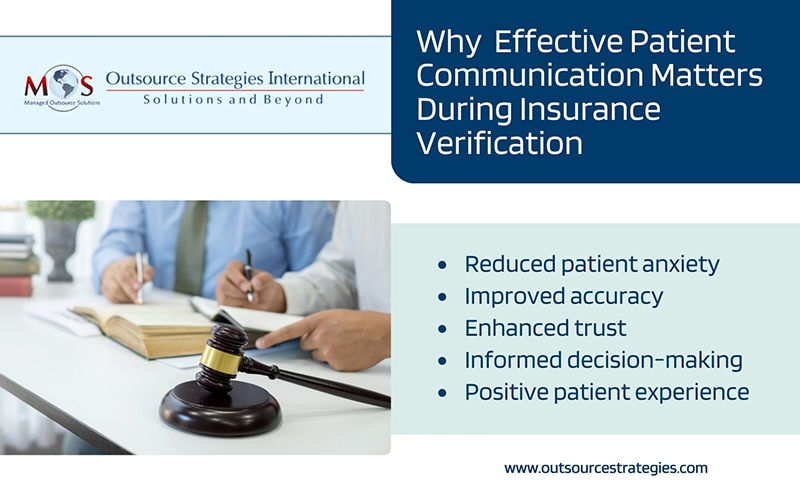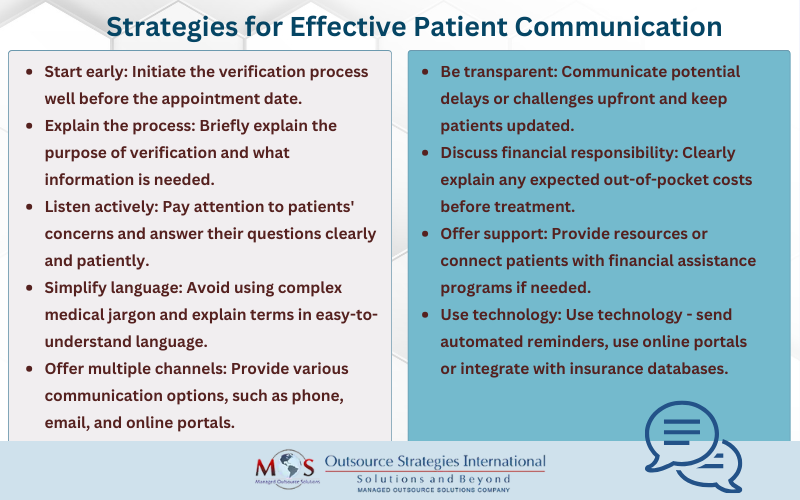Insurance verification is a critical process in medical billing. It ensures that healthcare practices have the correct coverage details to streamline claims processing. Insurance verification services safeguard against errors, reduce claim rejections, and accelerate revenue cycles, ultimately enhancing the financial health of the practice. Effective patient communication plays a key role in the eligibility verification process. Timely and clear communication ensures accurate information gathering and establishes trust between patients, healthcare providers, and insurance companies.
Effectively communicating insurance verification information to patients within a healthcare practice is paramount for fostering transparency, trust, and a positive patient experience. Patients need to be well-informed about their insurance coverage details, potential out-of-pocket expenses, and any requirements for pre-authorization. Clear communication empowers patients to understand their financial responsibilities and helps them navigate the complexities of the insurance process with confidence. By proactively sharing this information, healthcare practices can reduce the likelihood of misunderstandings, billing disputes, and delays in treatment. Additionally, it enables patients to make informed decisions about their healthcare, encouraging a sense of partnership between healthcare providers and those they serve. Ultimately, transparent communication in verification builds a foundation of trust, contributing to improved patient satisfaction and a smoother operational workflow within the healthcare practice.
Let us check out the importance of patient communication and how it contributes to a seamless and transparent experience for all stakeholders involved. At OSI, we’re experienced in guiding patients through the entire process. Our dedicated team ensures seamless and accurate verification, helping patients understand their coverage and navigate the complexities of insurance with confidence.

The Significance of Patient Communication in Insurance Eligibility Verification
Effective communication mainly encourages patients to provide accurate information, leading to fewer verification errors and delays.
- Clear information collection: Communicating with patients is the first step in obtaining accurate and up-to-date information for verification. Clear and concise communication helps in gathering essential details such as policy information, personal identification, and contact details.
- Verification of coverage: Patients need to be informed about the verification process and the importance of ensuring that their insurance coverage is up-to-date. Clear communication helps in avoiding misunderstandings and ensures that patients are aware of their responsibility in providing accurate insurance information.
- Reducing errors and discrepancies: Miscommunication or misunderstandings during the verification process can lead to errors and discrepancies. Open and transparent communication with patients helps in clarifying any uncertainties, reducing the likelihood of inaccuracies in the insurance information provided.
- Setting expectations: Proper communication also helps managing patient expectations in the verification process. It sets realistic expectations for patients regarding the coverage and potential out-of-pocket expenses. Patients are better prepared for any financial responsibilities, leading to improved satisfaction and trust in the insurance process.
- Educating patients: Patient communication is an opportunity to educate individuals about their insurance benefits, coverage limitations, and the importance of pre-authorization for certain procedures. Educated patients are more likely to actively participate in the verification process, facilitating smoother transactions.
- Handling sensitive information: Patient communication also involves addressing concerns about the privacy and security of personal health information. Clearly explaining the measures taken to safeguard patient data helps build trust and compliance with healthcare privacy regulations.
- Resolving queries promptly: Patients may have questions or concerns about the verification process. Establishing clear communication channels allows for the prompt resolution of queries, preventing delays and ensuring a positive patient experience.
- Ensuring informed consent: Clearly communicating the purpose of verifying insurance details and obtaining informed consent from patients is essential. This not only promotes transparency but also upholds ethical standards in handling patient information.
Implementing Effective Patient Communication Strategies
Educating patients on insurance coverage verification is paramount when it comes to making informed healthcare decisions. Implementing effective patient communication strategies is crucial to improve processes, minimize errors, and enhance overall patient satisfaction. Here are some proven patient communication strategies:
- Clear documentation: Ensure that all communication materials, including forms and instructions, are clear and understandable. Avoid jargon and use plain language to explain patient eligibility verification procedures, benefits, and any required information from the patient.
- Pre-appointment communication: Initiate communication well in advance of appointments, providing patients with details on what insurance information is required, why it is essential, and how it contributes to a smooth billing process. This can be done through appointment reminders, emails, or informational brochures.
- User-friendly patient portals: Utilize user-friendly online patient portals that allow individuals to access and update their insurance information easily. Provide step-by-step guides or video tutorials to assist patients in navigating these portals.
- Personalized communications: Tailor communication to the individual patient, addressing them by name and referencing specific insurance details. Personalization creates a more engaging and patient-centric approach, increasing the likelihood of accurate and timely responses.
- Multichannel communication: Employ a variety of communication channels such as emails, text messages, phone calls, and patient portal messages. This ensures that patients receive information through their preferred mode of communication, enhancing the likelihood of timely responses.
- Educational resources: Develop and distribute educational materials that explain insurance concepts, the importance of accurate information, and the steps patients can take to facilitate smooth verification. This empowers patients with the knowledge needed to actively participate in the process.
- Interactive workshops or webinars: Conduct interactive workshops or webinars to educate patients about insurance verification. This allows patients to ask questions in real time, fostering a better understanding of the insurance process and their role in providing accurate information.
- Prompt response handling: Establish clear guidelines for handling patient queries and ensure a prompt response to any questions. A responsive communication system builds trust and confidence in the healthcare practice.
By incorporating these patient communication strategies into the insurance verification process, healthcare practices can create a more transparent and patient-friendly experience. This facilitates accurate insurance information gathering and contributes to positive patient perceptions of the healthcare system.


Need tips in managing patient expectations in the verification process?
Talk to our OSI team.
Call (800) 670-2809 Today!






